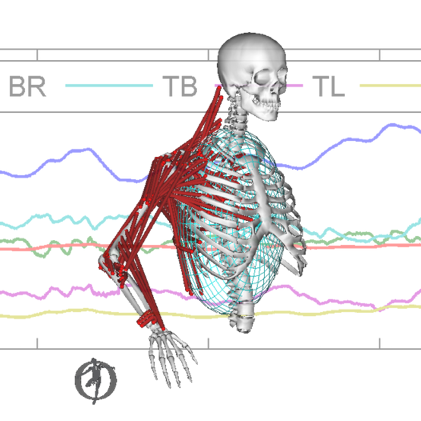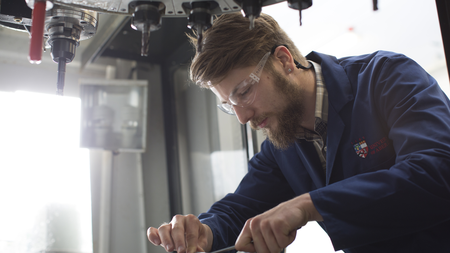
BEng, PhD, CEng, FHEA, MIPEM
Personal Chair
- About
-
- Email Address
- edward.chadwick@abdn.ac.uk
- Telephone Number
- +44 (0)1224 273840
- Office Address
- School/Department
- School of Engineering
Biography
Prof Chadwick is a Biomedical Engineer with research interests in biomechanics, modelling and simulation of human movement, and rehabilitation engineering. After gaining a first-class degree in Mechanical Engineering at Nottingham University, he went on to complete a PhD in Bioengineering at the University of Strathclyde in Glasgow.
Following international post-doctoral positions at the Technical University of Delft in the Netherlands, and Case Western Reserve University in Cleveland, Ohio, he returned to the UK in 2008. He was a Lecturer in Biomechanics at the University of Aberystwyth until 2012, and Lecturer / Senior Lecturer in Biomedical Engineering at Keele University until 2019.
Prof Chadwick joined the School of Engineering at Aberdeen as Reader in Bioengineering in October 2019, and became Director of Research for the School and Professor of Bioengineering in 2022.

MSc in Biomedical Engineering
As well as an active researcher in the field of rehabilitation engineering, biomechanics and human movement, I teach on the MSc in Biomedical Engineering, an interdisciplinary degree in which you'll learn to apply engineering techniques to solve important clinical problems.
Qualifications
- PhD Bioengineering1999 - Strathclyde University
- BEng Mechanical Engineering1993 - University of Nottingham
- PGC Teaching in Higher Education2012 - Aberystwyth University
Memberships and Affiliations
- Internal Memberships
-
- Director of Research, School of Engineering
- Member of Electrical Systems and Electronics Research Group
- Affiliate Member of Aberdeen Biomedical Imaging Centre
- External Memberships
-
Prof Chadwick has a number of roles external to the University:
- Member of the Engineering for Healthcare Thematic Leadership Group for the Scottish Research Partnership in Engineering.
- Member of the Institute for Physics and Engineering in Medicine Course Accreditation Committee, and Chair of the Engineering Course Accreditation Panel.
- Member of The International Society of Biomechanics (Executive Council Member 2013-17, Chair of the International Shoulder Group 2011-14).
- Member of the EPSRC Peer Review College, reviewer for other grant awarding bodies and journals in Biomedical Engineering.
- Former Member of the National Scientific Committee for the Inspire Foundation (2020 - 2024).
Latest Publications
Children and adolescents with all forms of shoulder instability demonstrate differences in their movement and muscle activity patterns when compared to age- and sex-matched controls
Journal of shoulder and elbow surgery, vol. 33, no. 9, pp. e478-e491Contributions to Journals: ArticlesCoupled, closed-system fluidic actuators for use in wearable rehabilitation devices
Chapters in Books, Reports and Conference Proceedings: Conference Proceedings- [ONLINE] DOI: https://doi.org/10.1109/ICRA48891.2023.10160422
- [ONLINE] View publication in Scopus
Use and evaluation of assistive technologies for upper limb function in tetraplegia.
Journal of Spinal Cord Medicine, vol. 45, no. 6, pp. 809-820Contributions to Journals: ArticlesHealthcare applications of single camera markerless motion capture: a scoping review
PeerJ, vol. 10, e13517Contributions to Journals: ArticlesAutomated Ultrasound Video Enhancement
Chapters in Books, Reports and Conference Proceedings: Conference Proceedings- [ONLINE] DOI: https://doi.org/10.1109/ICICT52195.2021.9568471
- [ONLINE] View publication in Scopus
- Research
-
Research Overview
The goal of my research is to apply engineering principles to facilitate restoration of function in people with activity-limiting movement disorders of the upper limb arising from neuromuscular conditions, orthopaedic problems and limb difference. The restoration of function can allow the resumption of independent living, the maintenance of health through exercise and the reduction of pain and discomfort.
My areas of expertise are in shoulder biomechanics, modelling and simulation of movement, human movement analysis, Functional Electrical Stimulation and advanced prosthetic devices.
Research Areas
Accepting PhDs
I am currently accepting PhDs in Engineering.
Please get in touch if you would like to discuss your research ideas further.

Research Specialisms
- Biomechanics
- Biomedical Engineering
- Prosthetics and Orthotics
- Rehabilitation Studies
- Mathematical Modelling
Our research specialisms are based on the Higher Education Classification of Subjects (HECoS) which is HESA open data, published under the Creative Commons Attribution 4.0 International licence.
Current Research
One of my main areas of research currently is the development of real-time models for the simulation of arm and hand function. A musculoskeletal model that can simulate the dynamics of the human arm in real time allows the creation of a realistic 'virtual arm'. This can be used as a replacement for the real arm in the development and testing of advanced neural prosthesis systems, or as a controller for a myoelectric prosthesis. This also allows rapid development and extensive testing of complex devices whilst reducing the burden on human participants.
Alongside bioengineering and the development of assistive technologies, I am interested in understanding more about the normal and pathological function of the upper limb musculoskeletal system, in particular the shoulder. As such, part of my work also attempts to apply the modelling and simulation tools that we develop to understanding more about shoulder function and stability, both in terms of the glenohumeral joint and control of the scapula.
Finally, I am working with clinical colleagues at a specialist orthopaedic hospital on a project to improve the understanding of foot deformity in children with cerebral palsy. It is hoped that better understanding through advanced measurement and modelling will lead to better treatments to address pain and mobility issues.
Personalised Approach to Restoration of Arm Function in People with High-Level Tetraplegia
The goal of this EPSRC-funded research is to create technology that improves the independence of people living with spinal cord injury. Specifically, we are using personalised models of the biomechanics of people's upper limbs to optimise FES interventions. FES stands for Functional Electrical Stimulation and involves generating muscle contraction in otherwise paralysed muscles. Appropriate stimulation of the muscles, coordinated by an external controller, can be used to achieve arm function.
Funding and Grants
- 2021 – 24 Private Physiotherapy Educational Foundation, Shoulder instability in children: understanding muscle activity and movement pattern differences, Co-I, £30k.
- 2021 – 23 Action Medical Research, Exploration of the role of subtalar joint morphology in the development of foot deformity in cerebral palsy, Co-I, £148k.
- 2018 – 22 Engineering and Physical Sciences Research Council, Personalised approach to restoration of arm function in people with high-level tetraplegia, PI, £387k.
- 2017 – 18 Institute for Physics and Engineering in Medicine, Intelligent FES for restoring arm movement in people with tetraplegia, PI, £10k.
- 2016 – 19 Orthopaedic Institute, Robert Jones and Agnes Hunt Orthopaedic Hospital, Biomechanical modelling of toe walking gait to inform the prescription of ankle foot orthoses in children with cerebral palsy (AFOs), Co-Investigator, £44k.
- 2015–20 National Institute of Child Health and Human Development (NIH), Intracortical control of FES-restored arm and hand function in people with SCI, subcontract with Case Western Reserve University, £38k.
- 2015–18 Engineering and Physical Sciences Research Council, Enabling Technologies for Sensory Feedback in Next-Generation Assistive Devices, Co-Investigator, collaboration with Newcastle (lead), Leeds, Essex, Southampton and Imperial College, £1.44m.
- 2014–17 Iraqi Ministry of Higher Education and Scientific Research, Image-based estimation of musculoskeletal parameters for patient-specific modelling, PhD studentship, £53k.
- 2014–16 Guy Hilton Asthma Trust, Validation of Structured Light Plethysmography in Acute Viral Bronchiolitis, Principal Investigator, collaboration with University Hospitals of North Midlands, £30k.
- 2013–15 Pneumacare Ltd, Validation of Structured Light Plethysmography: Pre/Post Bronchodilation Challenge, Principal Investigator, collaboration with University Hospitals of North Midlands, £29k.
- 2012–15 National Institute of Biomedical Imaging and Bioengineering (NIH subcontract via Rehabilitation Institute of Chicago), Software development for musculoskeletal simulations, £31k.
- 2013–14 Keele University MRC Centenary Funding (Bridging the Gaps), Continuous control of advanced myoelectric prostheses, PI, £6.5k.
- 2006–8 Telemedicine & Advanced Technology Research Center, Prosthetic arm control device for amputees, Research Co-investigator.
- 2005–8 National Institute of Child Health and Human Development (NIH), Controller development for upper limb movement, Research Co-investigator.
- 2005–8 National Institute of Neurological Disorders and Stroke (NIH), Restoration of Hand and Arm Function by Functional Electrical Stimulation, Research Coinvestigator.
- Teaching
-
Programmes
- Postgraduate, 3 semester, September start
Teaching Responsibilities
Prof Chadwick’s teaching focuses mainly on biomechanics, healthcare technologies, medical devices and other areas related to biomedical engineering.
Course Coordinator & lead contributor
- Fundamentals of Engineering in Medicine
- Rehabilitation Engineering and Biomechanics
Past Contributions
- Research Methods for Bioengineers
- Introduction to Engineering for Life Scientists
- Human Factors Engineering
- Fearsome Engines
He founded the MSc Biomedical Engineering and led it from 2020 - 2024.
Non-course Teaching Responsibilities
Individual project supervision at both undergraduate and postgraduate levels.
- Publications
-
Page 3 of 4 Results 51 to 75 of 83
MODEL-BASED DEVELOPMENT OF A NEUROPROSTHESIS CONTROLLER
n/aContributions to Journals: ArticlesNeural network controller for an upper extremity neuroprosthesis
Chapters in Books, Reports and Conference Proceedings: Conference Proceedings- [ONLINE] DOI: https://doi.org/10.1109/CNE.2005.1419641
Evaluation of test regimes for stab-resistant body armour
Proceedings of the Institution of Mechanical Engineers. Part L, Journal of Materials - Design and Applications, vol. 218, no. 4, pp. 355-361Contributions to Journals: Articles- [ONLINE] DOI: https://doi.org/10.1177/146442070421800409
Effectiveness of tendon transfers for massive rotator cuff tears: a simulation study
Clinical Biomechanics, vol. 19, no. 2, pp. 116-122Contributions to Journals: Articles- [ONLINE] DOI: https://doi.org/10.1016/j.clinbiomech.2003.09.008
Adaptive neural network controller for an upper extremity neuroprosthesis
Chapters in Books, Reports and Conference Proceedings: Conference Proceedings- [ONLINE] DOI: https://doi.org/10.1109/IEMBS.2004.1404153
Biomechanical analysis of scapular neck malunion--a simulation study
Clinical Biomechanics, vol. 19, no. 9, pp. 906-912Contributions to Journals: Articles- [ONLINE] DOI: https://doi.org/10.1016/j.clinbiomech.2004.06.013
Biomechanical analysis of tendon transfers for massive rotator cuff tears
Clinical Biomechanics, vol. 19, no. 4, pp. 350-357Contributions to Journals: Articles- [ONLINE] DOI: https://doi.org/10.1016/j.clinbiomech.2003.11.013
Toward standardized procedures for recording and describing 3-D shoulder movements
Behavior Research Methods, Instruments, Computers, vol. 35, no. 3, pp. 440-446Contributions to Journals: Articles- [ONLINE] DOI: https://doi.org/10.3758/bf03195521
Muscle oxygen consumption, determined by NIRS, in relation to external force and EMG
Journal of Biomechanics, vol. 36, no. 7, pp. 905-912Contributions to Journals: Articles- [ONLINE] DOI: https://doi.org/10.1016/S0021-9290(03)00081-2
Discriminating factors for functional outcome after shoulder arthroplasty a critical review of the literature
Acta Orthopaedica Belgica, vol. 69, no. 2, pp. 127-136Contributions to Journals: ArticlesBIOMECHANICAL MODELLING FOR COMPUTER-ASSISTED SURGICAL PLANNING
Contributions to Conferences: AbstractsCombined inverse/forward dynamic optimization of a large-scale biomechanical model of the shoulder and elbow
Contributions to Conferences: PapersMechanical load in the shoulder during wheelchair-related activities
Chapters in Books, Reports and Conference Proceedings: Conference ProceedingsMusculo-skeletal modelling of the shoulder
Chapters in Books, Reports and Conference Proceedings: Conference ProceedingsA forward-dynamic shoulder and elbow model
Contributions to Conferences: PapersBiomechanical analysis of scapular neck misalignment after fracture
Chapters in Books, Reports and Conference Proceedings: Conference ProceedingsKinematics during selected activities of daily in patients with a shoulder endoprosthesis
Gait and Posture, vol. 16, pp. 164-164Contributions to Journals: AbstractsMotion patterns of the shoulder for patients with a shoulder endoprosthesis during combing hair
Chapters in Books, Reports and Conference Proceedings: Conference ProceedingsRelationship between mechanical cost functions and muscle oxygen consumption
Chapters in Books, Reports and Conference Proceedings: Conference ProceedingsUpper extremity musculoskeletal models: can they be used for computer assisted surgery?
Chapters in Books, Reports and Conference Proceedings: Conference ProceedingsA novel force transducer for the measurement of grip force
Journal of Biomechanics, vol. 34, no. 1, pp. 125-128Contributions to Journals: Articles- [ONLINE] DOI: https://doi.org/10.1016/S0021-9290(00)00168-8
A large-scale musculoskeletal model of the shoulder and elbow: The Delft Shoulder (and elbow) Model
Chapters in Books, Reports and Conference Proceedings: Conference ProceedingsComputer assisted surgery of the shoulder: validation of a model using a tendon transfer operation
Chapters in Books, Reports and Conference Proceedings: Conference ProceedingsFunctional elevation of the shoulder
Chapters in Books, Reports and Conference Proceedings: Conference ProceedingsModelling shoulder function and strength after scapular neck fracture
Chapters in Books, Reports and Conference Proceedings: Conference Proceedings
